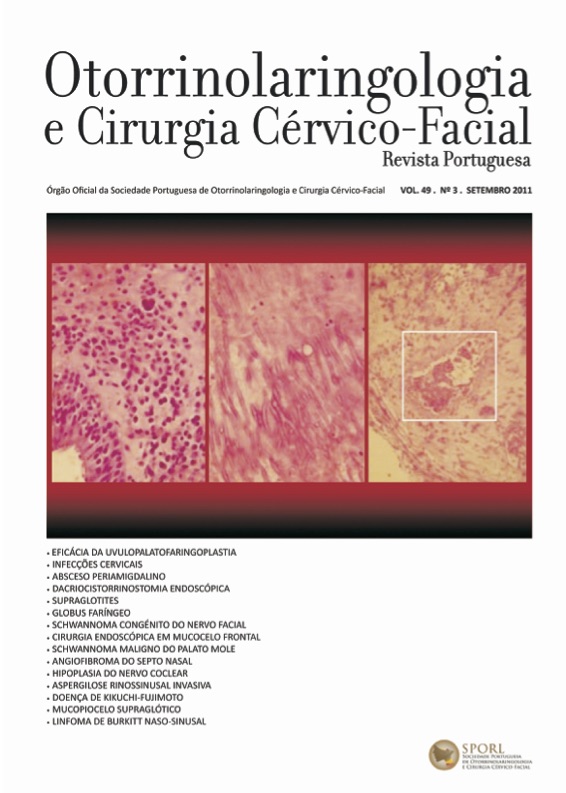Efficacy of uvulopalatopharyngoplasty: Retrospective study
DOI:
https://doi.org/10.34631/sporl.171Keywords:
uvulopalatopharyngoplasty, roncopathy, obstructive sleep apnea syndrome, polysomnographyAbstract
Roncopathy is a common disorder in general population, being the prevalence of Obstructive Sleep Apnea Syndrome (OSAS) between snorers , of at least 10%.
The authors present a review of 35 patients of their department selected for uvulopalatopharyngoplasty (UPPP) between 2001 and 2006. Surgical results are evaluated by comparing the parameters of polysomnography (PSG) before and after surgery and, subjectively, through a questionnaire defined by the department.
We studied 35 patients (83% male and 17% female) with mean pre-surgery apnea-hypopnea index (AHI) of 22.9 ± 17.6 events/hour. The percentage of cure after UPPP was 33%, by Sher’s criteria for cure. There was no significant difference between mean AHI before and after surgery. As for the subjective long-term evaluation, 68% of patients maintained a reduction of snoring, 61% reported decreased daytime sleepiness and 56% of the number of apneas during the night witnessed by the spouse.
The lack of correlation between the results measured by PSG and subjective outcomes perceived by the patient, stresses the need to follow these patients and repeat the sleep study.
Downloads
References
- Bixler EO, Vgontzas NA, Lin HM, et al. Prevalence of sleepdisordered breathing in women: effects of gender. Am J Rspir Crit Care Med.Mar 2001;163:608-13
– Young T, Palta M, Dempsey J, Skatrud J, Weber S, Badr S. The occurrence of sleep-disordered breathing among middle-aged adults. N Engl J Med. 1993 Apr 29;328(17):1230-5.
- Marin JM, Carrizo SJ, Vicente E, Agusti AG. Long-term cardiovascular outcomes in men with obstructive sleep apnoea-hypopnoea with or without treatment with continuous positive airway pressure: an observational study. Lancet. 2005 Mar 19-25;365(9464):1046-53.
- Ip MS, Lam B, Ng MM, et al. Obstructive sleep apnea is independently associated with insulin resistance. Am J Respir Crit Care Med. Mar 2002;165:670-6
- Becker HF, Jerrentrup A, Ploch T, Grote L, Penzel T, Sullivan CE, Peter JH. Effect of nasal continuous positive airway pressure treatment on blood pressure in patients with obstructive sleep apnea. Circulation. 2003 Jan 7;107(1):68-73.
- Rosenberg R, Doghramji P. Optimal treatment of obstructive sleep apnea and excessive sleepiness. Adv Ther. 2009 Mar;26(3):295-312. Epub 2009 Apr 3. Review.
– Friberg D, Carlsson-Nordlander B, Larsoon H, Svanborg E. UPPP for habitual snoring: a 5-year follow-up with respiratory sleep recordings. Laryngoscope 1995;105:519-22
– Maisel RH, Antonelli PJ, Iber C, et al. Uvulopalatopharyngoplasty for obstructive sleep apnea: a community’s experience. Laryngoscope 1992;102:604-7
– Goh YH, Mark I, Fee WE Jr. Quality of life 17 to 20 years after uvulopalatopharyngoplasty. Laryngoscope 2007;117:503-6
- Larsson LH, Carlsson-Nordlander B, Svanborg E. Four-year followup after uvulopalatopharyngoplasty in 50 unselected patients with obstructive sleep apnea syndrome. Laryngoscope 1994;104:1362-8
- Maisel RH, Antonelli PJ, Iber C, et al. Uvulopalatopharyngoplasty for obstructive sleep apnea: a community’s experience. Laryngoscope 1992;102:604-7
- Senior BA, Rosenthal L, Lumley A, Gerhardstein R, Day R. Efficacy of uvulopalatopharyngoplasty in unselected patients with mild obstructive sleep apnea. Otalaryngol Head Neck Surg 2000;123:179-82
- Horner RL, Mohiaddin RH, Lowell DG, Shea SA, Burman ED, Longmore DB, Guz A. Sites and sizes of fat deposits around the pharynx in obese patients with obstructive sleep apnoea and weight matched controls. Eur Respir J. 1989 Jul;2(7):613-22
- Friedman M, Ibrahim H, Joseph NJ. Staging of obstructive sleep apnea/hypopnea syndrome: a guide to appropriate treatment. Laryngoscope. 2004 Mar;114(3):454-9.
- Li HY, Chen NH, Shu YH, Wang PC. Changes in quality of life and respiratory disturbance after extended uvulopalatal flap surgery in patients with obstructive sleep apnea. Arch Otolaryngol Head Neck Surg. 2004 Feb;130(2):195-200.
- Sher AE, Schechtman KB, Piccirillo JF. The efficacy of surgical modifications of the upper airway in adults with obstructive sleep apnea syndrome. Sleep. 1996 Feb;19(2):156-77.
- Li HY, Wang PC, Lee LA, Chen NH, Fang TJ. Prediction of uvulopalatopharyngoplasty outcome: anatomy-based staging system versus severity-based staging system. Sleep. 2006 Dec 1;29(12):1537-41.
- Friedman M, Vidyasagar R, Bliznikas D, Joseph N. Does severity of obstructive sleep apnea/hypopnea syndrome predict uvulopalatopharyngoplasty outcome? Laryngoscope. 2005 Dec; 115(12):2109-13.
- Pepperell JC, Ramdassingh-Dow S, Crosthwaite N, Mullins R, Jenkinson C, Stradling JR, Davies RJ. Ambulatory blood pressure after
therapeutic and subtherapeutic nasal continuous positive airway pressure for obstructive sleep apnoea: a randomised parallel trial. Lancet. 2002 Jan 19;359(9302):204-10.
- Neruntarat C. Genioglossus advancement and hyoid myotomy: short-term and long-term results. J Laryngol Otol. 2003 Jun;117(6):482-6.
- McMains KC, Terris DJ. Evidence-based medicine in sleep apnea surgery. Otolaryngol Clin N Am 2003;36:539-61.
- Keena SP, Burt H, Ryan CF, Fleetham JA. Long-term survival of patients with obstructive sleep apnea treated by uvulopalatopharyngoplasty or nasal CPAP. Chest 1994;105:155-9.






